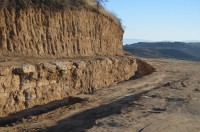 Excitement is mounting in Greece over the excavation of a vast tomb atop Kasta hill in the ancient Central Macedonian city of Amphipolis. The Kasta Tumulus was first excavated in 2012, revealing a circular tomb almost 10 feet high (eroded from an estimated original height of 80 feet), 525 feet in diameter and 1,640 feet in circumference, making it significantly larger than the Great Tumulus at Vergina (43 feet high, 360 feet in diameter) that houses the tombs of Philip II of Macedon and other members of the royal family. In fact, it’s the largest tomb ever discovered in Greece.
Excitement is mounting in Greece over the excavation of a vast tomb atop Kasta hill in the ancient Central Macedonian city of Amphipolis. The Kasta Tumulus was first excavated in 2012, revealing a circular tomb almost 10 feet high (eroded from an estimated original height of 80 feet), 525 feet in diameter and 1,640 feet in circumference, making it significantly larger than the Great Tumulus at Vergina (43 feet high, 360 feet in diameter) that houses the tombs of Philip II of Macedon and other members of the royal family. In fact, it’s the largest tomb ever discovered in Greece.
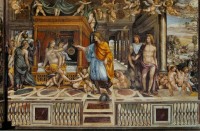 Almost as soon as digging began, speculation exploded in the media about who might be buried in such a monumental tomb. Could it be Roxana of Bactria, last wife of Alexander the Great, and their son Alexander IV Aegus? According to historian Diodorus Siculus (The Library of History, Book 19, Chapter 52 and 105), they were imprisoned and killed in Amphipolis by Cassander, distant relative of Alexander the Great and Regent of Macedon, in around 310 B.C. Siculus says Cassander had his minion kill them and conceal the bodies. The largest tumulus in Greece doesn’t seem like an ideal spot to conceal anything. Outside of the fever dreams of the press, therefore, there is zero historical evidence that mother and son were interred in Amphipolis and zero archaeological evidence attesting to who was interred in the tumulus.
Almost as soon as digging began, speculation exploded in the media about who might be buried in such a monumental tomb. Could it be Roxana of Bactria, last wife of Alexander the Great, and their son Alexander IV Aegus? According to historian Diodorus Siculus (The Library of History, Book 19, Chapter 52 and 105), they were imprisoned and killed in Amphipolis by Cassander, distant relative of Alexander the Great and Regent of Macedon, in around 310 B.C. Siculus says Cassander had his minion kill them and conceal the bodies. The largest tumulus in Greece doesn’t seem like an ideal spot to conceal anything. Outside of the fever dreams of the press, therefore, there is zero historical evidence that mother and son were interred in Amphipolis and zero archaeological evidence attesting to who was interred in the tumulus.
With Greece’s economy in deep recession, there was no budget to continue excavations or even to secure the site, now exposed to the world in injudiciously excessive terms as a tomb of great historical interest. Archaeologists found Philip II buried in a 24-pound gold casket. Even the most distant possibility that someone in the Macedon royal family or adjacent thereto could be buried in the Kasta Tumulus would surely prove an irresistible lure to looters.
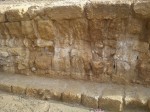 Somehow the money was scraped up to continue excavations and by Spring of 2013, much of the perimeter of the tomb had been unearthed. The foundation of the perimeter wall was built of large limestone blocks clad in marble from the island of Thasos, the same kind of marble used to make a sculpture known as the Lion of Amphipolis. The lion and blocks of marble were found in the Strymon river in the early 1910s. Greek soldiers dragged the blocks out of the river and used some of them
Somehow the money was scraped up to continue excavations and by Spring of 2013, much of the perimeter of the tomb had been unearthed. The foundation of the perimeter wall was built of large limestone blocks clad in marble from the island of Thasos, the same kind of marble used to make a sculpture known as the Lion of Amphipolis. The lion and blocks of marble were found in the Strymon river in the early 1910s. Greek soldiers dragged the blocks out of the river and used some of them 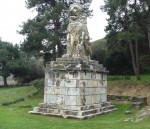 to build a base for the lion a few kilometers away from the Kasta Tumulus. The loose blocks and columns that weren’t used in the reconstruction are still there, grouped together next to the lion monument.
to build a base for the lion a few kilometers away from the Kasta Tumulus. The loose blocks and columns that weren’t used in the reconstruction are still there, grouped together next to the lion monument.
Many of the marble pieces from the tomb were missing, so Michaelis Lefantzis, the archaeological team’s architect, went looking among the lion’s marbles for blocks that may have come from the tomb. He found that 400 blocks from around the lion and 30 from the base were 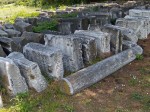 the same in shape, size and elaboration as the ones in the wall encircling the tumulus. It seems the Romans stripped them in the 2nd century A.D. and used them to stabilize the banks of the river. Archaeologists believe the lion was once perched on the top of the tomb before it was tossed in the Strymon.
the same in shape, size and elaboration as the ones in the wall encircling the tumulus. It seems the Romans stripped them in the 2nd century A.D. and used them to stabilize the banks of the river. Archaeologists believe the lion was once perched on the top of the tomb before it was tossed in the Strymon.
The discovery underscored what an impressive monumental structure the tumulus was in antiquity. Now archaeologists are on the verge of getting inside and maybe discovering who was so important as to garner such a fancy final resting place.
So far, workers have unveiled a flight of 13 steps that lead to a broad path, flanked by masonry walls, which end in a built-up arch covering two headless, wingless sphinxes — mythical creatures that blend human, bird and lion characteristics.
Archaeologists believe the entrance will be unearthed by the end of the month. They haven’t found any evidence of tomb raider activity, no tunneling, no break-ins, so they expect to find an intact tomb. Anticipation is so high the Prime Minister of Greece, Antonis Samaras, visited the site Tuesday, calling the tumulus “clearly extremely important.”